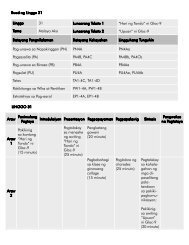Learning Package
Learning Package - baitang7 - WordPress.com
Learning Package - baitang7 - WordPress.com
- No tags were found...
You also want an ePaper? Increase the reach of your titles
YUMPU automatically turns print PDFs into web optimized ePapers that Google loves.
Task 6. Practice Makes Perfect!<br />
Study the consistency of tense in the paragraphs on the following page. On a half<br />
sheet of paper, write C if the sentence correctly observes rules on tense consistency. If<br />
it does not, rewrite the sentence and box the verb, the form of which must show its<br />
correct tense.<br />
Paragraph 1<br />
1 The wide island of Panay was originally inhabited by Negritos or locally called<br />
Ati tribe. 2 Their disappearance is due to an innocent agreement they made with the<br />
sultan of Borneo back in 1250 to give up their land in exchange of a hat and gold<br />
necklace. 3 Early in the 13th century, Marikudo, a native chieftain, sold the coastal<br />
shores and lowlands to 10 Bornean Datus who escapes from the repression of Sri<br />
Vishayan Empire. 4 One of them named Paiburong received the area Irong-Irong,<br />
which is now called Iloilo City, meaning nose-like, as its wide river mouth in the narrow<br />
Guimaras Strait appears like a snout. 5 The island lived peacefully until the arrival of<br />
Juan Miguel de Legazpi in 1566 that discovered and developed more towns.<br />
http://www.camperspoint.com/spip.php?article241<br />
Paragraph 2<br />
1 The Filipinos in central Philippines are generally and collectively called<br />
Visayans or Bisayans. 2 Hence, the people in Panay, Guimaras and Negros Occidental<br />
are referred to as "Visayans" or "Bisayans". 3 Aside from the general names given to<br />
the people of the Visayan region, there are mountain people who lived in the interior<br />
mountains of Panay and Negros. 4 In Panay, they were generally referred to as<br />
Bukidnon (literally, "from the mountains") or Sulod (literally, "inside" or "interior").<br />
5 Farming and fishing are the main sources of livelihood in the region until the 1960s.<br />
6 Farmers within the interior mountains of Central Panay employed the kaingin system<br />
(slash-and-burn). 7 A bolo and a wooden dibble were all they use for cutting trees and<br />
for boring holes to drop rice or corn seeds and legumes into. 8 Most houses have<br />
bangkaw (spear) as hunting tool. 9 Hunting greatly decreased in the 1970s with the<br />
gradual disappearance of forests, but kaingin still remained to be the primary form of<br />
farming since the interior mountain are rugged and they have not found the<br />
appropriate technology to harness water.<br />
National Commission for Culture and Arts, http://www.ncca.gov.ph<br />
Task 7. A Polished Finish<br />
Tense consistency is important in writing news reports. On a whole sheet of<br />
paper, revise the following news report so that rules on tense consistency are observed.<br />
ILOILO CITY – 1 An award-winning epic-chanter who belonged to an indigenous group<br />
on Panay Island has raised concerns over the depiction of its cultural beliefs and<br />
practices on GMA 7‘s new series, ―Amaya.‖<br />
2 Federico Caballero, 73, an elder of the Panay-Bukidnon community, said that,<br />
while the show may be fictional, the portrayal of its people‘s practices, terms and<br />
beliefs are inaccurate. 3 ―Some of the things depicted do not reflect our culture,‖<br />
Caballero tells the Philippine Daily Inquirer.<br />
Grade 7 English <strong>Learning</strong> <strong>Package</strong> 27









